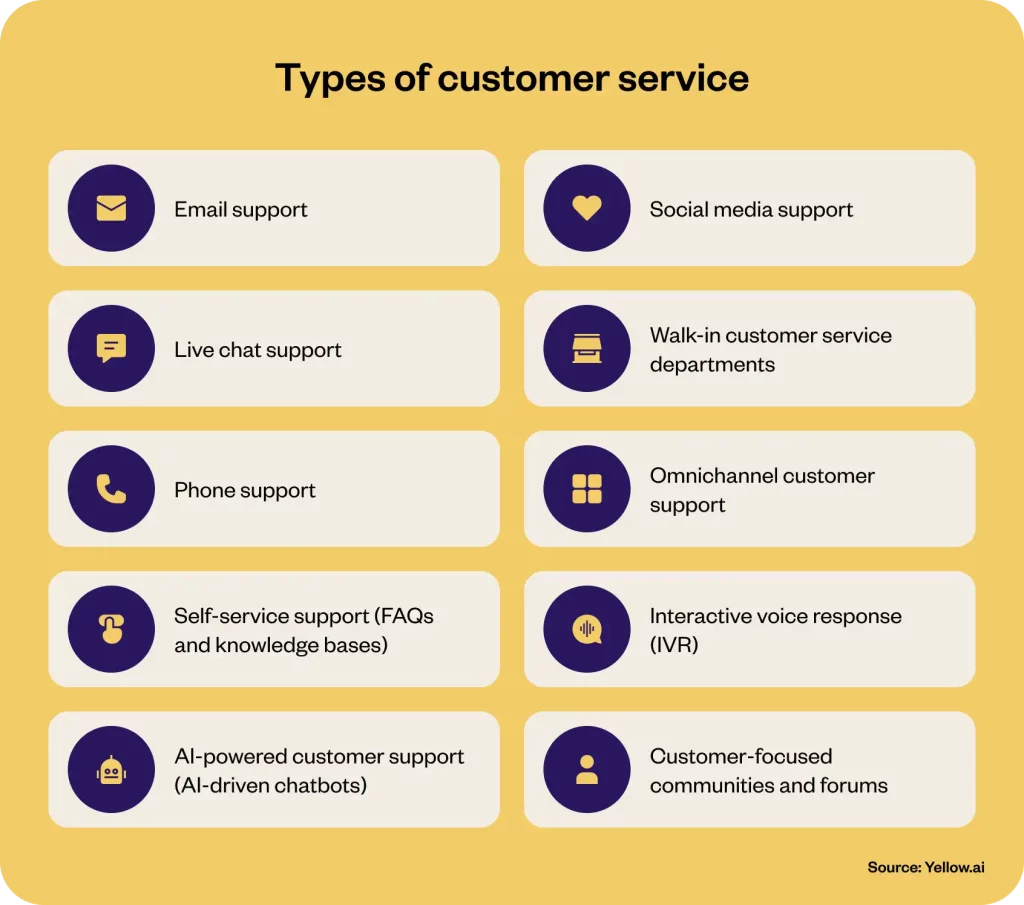Summary
The types of customer service businesses provide, reflect their commitment to customer satisfaction and dedication to delivering outstanding customer service and value. Understanding that keeping customers happy is not just a goal but a business imperative, the need for an adept customer service team and different types of customer service is essential.
A Salesforce study reveals that 79% of customers expect consistent interactions across various departments and to provide such consistent interactions it is a vital necessity for businesses to equip themselves with a comprehensive customer service toolkit. Such a toolkit empowers companies to offer a spectrum of top-notch customer services, meeting and exceeding the dynamic expectations of today’s savvy consumers.
Related must-reads:
- Customer service automation – A full guide
- Customer service software: How to select the best one
- Good customer service: Ways to deliver [+10 Examples]
- 10 Bad customer service examples (How to fix them)
Top 10 types of customer service essential for today’s businesses
In this blog, we will unfold the pivotal role of different types of customer service in cementing business success. We’ll delve into how these services respond to customer needs and shape the essence of customer-business interactions. Here are the different types of customer services.
- Email support
- Live chat support
- Phone support
- Self-service support (FAQs and knowledge bases)
- AI-powered customer support: (AI-driven chatbots)
- Social media support
- Walk-in customer service departments
- Omnichannel customer support
- Interactive voice response (IVR)
- Customer-focused communities and forums
What is customer service?
Customer service is the assistance provided to customers in their entire buying process, including before, during, and after the purchase. It is a crucial link between customers and businesses, ensuring a seamless journey from initial inquiry to ultimate contentment. Customer service is not merely a service but rather an encounter, a communication, and a connection.
Customer service has expanded beyond traditional methods in the digital age. It is no longer limited to in-person or telephone interactions. Contemporary customer service is complex and adaptable, operating across different channels and platforms. This transformation results from consumer behavior and preference changes, requiring businesses to be more flexible and prompt in their service delivery.
Why is customer service important for your business?
Customer service serves as the primary interface between the company and its customers. It’s not just about resolving issues; it’s a critical driver of customer satisfaction, loyalty, and advocacy. In an era of abundant choices and fierce competition, offering superior customer service can significantly differentiate your business, turning satisfied customers into loyal advocates and contributing directly to your bottom line. The impact of customer service on business success is underscored by compelling statistics:

- 84% of businesses have recorded higher revenues by improving customer service, highlighting the direct correlation between service quality and financial performance.
- 72% of customers are likely to refer your business to more than six people if they are satisfied and happy, emphasizing the power of positive customer experiences in driving organic growth.
- 69% of customers will recommend your business to others if they have a positive experience, showcasing the significance of each customer interaction.
- 75% of customers will become returning buyers if you provide excellent service, illustrating the critical role of customer service in customer retention.
- 89% of customers will turn to your competitor if you provide poor service, indicating the high stakes of customer service in maintaining market share.
- 68% of customers won’t return to your business once lost, stressing the importance of getting customer service right the first time.
These statistics showcase the importance of customer service and serve as a powerful reminder of its impact on a business’s growth and sustainability.
Related read: Customer service chatbots: Benefits and examples [2024]
Types of customer service
With a spectrum of channels and methods available, choosing the right approach to customer service is more crucial than ever. Each method caters to customers’ unique needs and reflects the business’s commitment to customer care. Let’s explore the different types of customer service and understand how they can transform customer interactions into lasting relationships.

1. Email support
Email support, embraced by 90% of organizations, thrives on asynchronous communication, allowing customers and businesses to engage in detailed discussions at their own pace. This method has become integral to customer service strategies, facilitating a direct line of communication where customers can elaborate on their issues with attachments and detailed explanations.
Pros:
- Multiple query handling: Enables support agents to handle multiple queries simultaneously, enhancing efficiency.
- Comprehensive email history: Keeps a comprehensive email history for tracking and analyzing customer interactions.
- Cost-effective solution: Cost-effective, often requiring only a shared inbox for smaller businesses.
- Documented communication trail: Provides a documented trail of communication, reducing confusion and improving clarity.
Cons:
- Slower response times: Response rates may lag behind real-time channels such as phone or live chat.
- Preference for direct interaction: May not meet the needs of customers seeking more immediate or personal communication.
With the right email management software, email support can be one of the most straightforward ways to organize customer service efforts. It’s a primary channel for external customer support and a common medium for internal support among Human Resources, Payroll, and IT departments. This dual utility underscores email support’s versatility and enduring relevance in customer and employee relations.
2. Live chat support
Live chat support emerges as a dynamic and real-time solution within the customer support landscape, crucial for businesses aiming for instant customer interaction. It fosters a personal and immediate connection, mirroring the in-person customer service experience. With 52% of consumers prefer live chat companies, this feature caters to the demand for quick responses. It addresses the modern customer’s need for instant gratification, making it a vital tool for enhancing customer satisfaction and reducing churn rates.
Related read: What is live chat? The definitive guide for businesses
Pros:
- Immediate response: Real-time support drastically reduces wait times for customers.
- Efficiency: Agents can manage multiple chats simultaneously, boosting productivity.
- Documentation: Chat transcripts are saved for quality assurance and future reference.
- Conversion rates: Consumers using live chat are 2.8 times more likely to convert.
Cons:
- Language barriers: Challenges may arise if the support team and customers do not have a common language or have different proficiencies.
- Complex issues: Some inquiries might be too intricate for live chat, necessitating a shift to other channels, which can be frustrating.
Live chat support is an indispensable feature for businesses in an era where timely and personalized customer service is appreciated and expected. It represents a strategic investment in customer experience, directly influencing potential customers to engage with your business confidently.
3. Phone support
Phone support remains a vital channel in customer service, favored for its direct and immediate communication. With 87% of B2B organizations utilizing it and 61% of customers preferring it for issue resolution, its importance is undeniable. This method delivers personalized, real-time solutions, fostering a sense of connection and value among customers.
Pros:
- Immediate assistance: Enables real-time problem-solving and direct dialogue.
- Complex issue resolution: More effective for intricate problems through verbal communication.
- Personalized experience: Creates a responsive, interactive conversation that values the customer.
- Strong customer connection: Builds rapport and trust through personal interaction.
- Efficiency: With integrated software, phone support can offer insights and streamline call management, enhancing service quality.
Cons:
- Wait times: Potential delays during high call volumes.
- Communication barriers: Language and accents may impact clarity.
Effective phone support hinges on accessibility, the right technology, and considerate customer interaction choices, from greetings to hold music. Despite digital advancements, the need for a human connection in resolving complex or urgent issues keeps phone support crucial in customer service.
Related read: Call center software – A Complete Guide [2024]
4. Self-service support (FAQs and knowledge bases)
Self-service support has revolutionized how customers interact with businesses, offering a proactive approach to problem-solving. By leveraging FAQs, knowledge bases, product guides, and video tutorials, this support type enables customers to find answers independently, anytime and anywhere. 65% of customer service leaders report decreased support call volumes due to effective self-service options, underscoring its impact on operational efficiency.
Related read: Self customer service: Navigating the new era of empowered consumers
Pros:
- Empowers customers: Allows individuals to resolve issues independently, fostering a sense of autonomy.
- Reduces workload: Frees up agents to focus on more complex, high-touch interactions.
- 24/7 availability: Offers round-the-clock support, even outside standard business hours.
- Efficiency: Directs resources to handle intricate customer needs by alleviating basic inquiry pressure.
Cons:
- User skill level: Not all customers are comfortable or able to navigate self-help tools.
- Development and maintenance: Requires ongoing effort to keep resources relevant and helpful.
Self-service support is particularly suited for addressing common service requests, such as refunds, product questions, and billing inquiries, making it a strategic addition to any customer service toolkit.
5. AI-powered customer support (AI chat agents)
AI customer service solutions, especially through AI chat agents, represents a significant leap forward in how businesses interact with customers. Utilizing advancements in natural language processing (NLP) and artificial intelligence (AI), these automated systems offer an efficient and scalable solution to managing customer inquiries. Integrating AI enhances efficiency and brings a high degree of personalization. According to a Salesforce survey, 73% of customers expect increased personalization as technology advances, a demand that AI chat agents are uniquely positioned to meet.
Related read: AI Chatbot – A Complete Guide for [2024]
Pros:
- Immediate responses: Instantly addresses FAQs, improving customer satisfaction.
- Cost-effectiveness: Reduces the need for extensive human-agent teams.
- 24/7 availability: Ensures support is accessible anytime, enhancing convenience.
- High volume handling: Efficiently manages repetitive inquiries, allowing human agents to tackle complex issues.
Cons:
- Lacks human touch: Not all chatbots provide the personalized care some customers seek.
- Customer preference: Some users may prefer the experience of a human agent.
Furthermore, AI chatbots are instrumental in elevating the customer experience, a critical factor as 80% of customers state that the experience a company provides is as important as its products and services. By offering timely, personalized services, AI-driven support systems meet and exceed customer expectations, setting a new standard for customer engagement in the digital era.
6. Social media support
Social media support has become indispensable in the digital era, enabling businesses to meet customers where they spend considerable time on platforms like Facebook, Twitter, and Instagram. With 32% of organizations entrusting social customer service to their marketing teams and 24% adopting a collaborative approach between marketing and customer service departments, it’s clear that managing social interactions is a shared responsibility to enhance customer engagement and satisfaction.
Related read: An effective how-to guide for social media customer service
Pros:
- Enhanced engagement: Enables businesses to connect with customers in a familiar environment.
- Brand loyalty: Positive interactions on social media can increase customer loyalty and advocacy.
- Market insight: Direct feedback provides valuable insights into customer needs and market trends.
- Crisis management: Offers a platform for rapid response and management of customer service crises, mitigating potential negative impacts.
Cons:
- Management complexity: Keeping up with conversations across platforms demands dedicated effort.
- Public scrutiny: Every interaction is visible to the public, increasing the stakes of every response.
Social media support offers a unique blend of challenges and opportunities with the potential to impact brand perception and customer satisfaction significantly. By navigating its complexities with strategic insight and responsiveness, businesses can leverage social media to build stronger relationships with their audience and enhance their overall customer service experience.
7. Walk-in customer service departments
Walk-in customer service departments, a hallmark of traditional brick-and-mortar business models, represent a bygone era where direct, in-person customer support was the norm. Once a staple in consumer goods industries, these physical units are becoming less common as businesses shift towards digital platforms. Despite the digital pivot, walk-in customer service retains unique advantages in today’s market:
Pros:
- Personal connection: Face-to-face interactions foster a deeper understanding of customer issues and build trust.
- Product demonstration: Directly showcasing products can influence purchasing decisions and promote additional items.
- Nonverbal communication: Observing customers’ body language offers insights that virtual support can’t capture, allowing for more tailored service.
- Immediate solutions: Physical presence enables on-the-spot problem resolution, enhancing customer satisfaction.
Cons:
- Inefficiency: Customer’s need to visit a physical location can be slow and inconvenient.
- Customer discomfort: Physical encounters can escalate quickly if a customer is dissatisfied and demands immediate, sometimes challenging, resolutions.
To optimize walk-in customer service, businesses should focus on understanding nonverbal cues, ensuring all staff can guide customers effectively, and promoting products sensitively without pushing sales aggressively. This approach addresses the limitations of walk-in services and leverages their strengths in creating memorable customer experiences.
8. Omnichannel customer support
Omnichannel customer support represents the pinnacle of integrated customer service strategies, ensuring a seamless and consistent user experience across all channels. This approach harmonizes interactions whether a customer reaches out via social media, email, live chat, phone, or in-person visits, making every transition fluid and maintaining context throughout the customer journey.
Related read: A guide on omnichannel customer engagement
Pros:
- Effortless transition: Allows for the smooth handover of conversations between channels, enhancing problem-solving efficiency.
- Flexibility in communication: Offers customers the liberty to choose their most convenient support channel.
- Uniform experience: Ensures customers receive the same quality of service across all platforms.
- Enhanced customer insights: Collects data from multiple touchpoints, providing a comprehensive view of customer preferences and behaviors.
Cons:
- Consistency challenges: Achieving a uniform service quality across multiple platforms can be complex and resource-intensive.
- Technological demand: Requires sophisticated systems and integrations to manage diverse channels cohesively.
From a strategic standpoint, adopting an omnichannel approach not only caters to the modern consumer’s expectations for accessible, versatile support but also represents a commitment to excellence in customer service.
9. Interactive voice response (IVR)
Interactive Voice Response (IVR) systems have become a linchpin in modern customer service operations, automating the initial stages of customer interaction. IVR systems enhance the customer service experience while streamlining operational efficiency by efficiently handling inquiries and directing callers to the appropriate department.
Pros:
- 24/7 availability: Provides constant access to support, improving customer convenience.
- Reduced agent workload: Automates straightforward inquiries, allowing agents to concentrate on complex cases.
- Improved resolution rates: Increases the likelihood of solving issues on the first contact by accurately directing calls.
- Shortened call duration: Manages calls efficiently, reducing wait times for customers.
Cons:
- Impersonal experience: Can make interactions feel mechanical, lacking the warmth of human service.
- Navigation frustration: Complex or poorly designed menus can confuse and frustrate customers.
To mitigate these drawbacks, businesses continually refine their IVR systems to be more intuitive and user-friendly. Incorporating advanced voice recognition and natural language processing technologies can make IVR interactions more conversational and less mechanical, significantly improving the customer experience.
10. Customer-focused communities and forums
Customer-focused communities and forums represent a unique and increasingly popular approach to customer service powered by users. This model allows businesses to leverage collective knowledge and peer-to-peer support, significantly reducing overhead costs associated with traditional customer service channels. The key to success lies in building a robust and engaged community around the brand. However, this typically requires initial efforts to attract a sizeable following and a small team to moderate and maintain the integrity of the community.
Pros:
- Cost-effective: Minimal staffing requirements lower operational costs.
- Peer-to-peer support: Enables customers to share solutions and experiences.
- Valuable insights: Provides businesses with real-time feedback on customer needs and product issues.
- Self-sustaining resource: Creates a comprehensive knowledge base for current and future customers.
Cons:
- Limited control: Businesses have less influence over the consistency of support provided.
- Moderation challenges: Requires oversight to ensure positive and productive community interactions.
Mozilla’s SUMO (Support Mozilla) program exemplifies the power of community-driven customer service, relying entirely on community support for its open-source products without a traditional customer support team. By embracing customer-focused communities, businesses can transform their customer service strategy, creating a dynamic space where customers feel valued and engaged.
How Yellow.ai can help you automate your customer service team?
In the rapidly advancing customer service domain, Yellow.ai emerges as a leader in innovation, thanks to its next-gen AI-powered solutions. These sophisticated solutions are engineered to drastically improve customer service workflows, presenting companies with a harmonious mix of efficiency, customization, and growth potential. By automating standard queries and offering around-the-clock support, Yellow.ai refines customer interactions and liberates human agents to address more intricate concerns.
Let’s delve deeper into how Yellow.ai is revolutionizing customer service.
1. 24/7 availability
Yellow.ai provides continuous, round-the-clock assistance, ensuring that customers receive immediate support regardless of the time or day. This perpetual availability is crucial in today’s fast-paced world, where customers expect instant responses to their inquiries. It enhances customer satisfaction and engagement by offering initial guidance or resolving common queries at any hour, setting a new standard for service accessibility.
2. Handover chat to a human agent
When a customer’s issue surpasses the complexity that automated systems can handle, Yellow.ai solutions can smoothly transition the conversation to a human agent. This handover isn’t just a simple redirect; it includes the context of the problem discussed so far, ensuring that the customer doesn’t have to repeat themselves. This seamless integration between AI and human service significantly improves the efficiency of problem resolution and enhances the customer experience.
3. Omnichannel support
Deployability across multiple channels is a standout feature of Yellow.ai’s customer support suite, offering a consistent and unified customer service experience whether the customer reaches out via social media, email, live chat, or any other platform. This omnichannel presence means customers can interact with your brand on their preferred channel without compromising service quality or personalization, reinforcing brand loyalty and trust.
4. High personalization
Through data analysis and customer interaction patterns, Yellow.ai can deliver highly personalized service to each customer. This personalization extends beyond using the customer’s name; it involves tailoring responses based on the customer’s history, preferences, and behavior, making each interaction feel unique and valued. Such personalized experiences increase customer satisfaction and drive engagement and retention.
5. Sentiment analysis
One of the advanced capabilities of Yellow.ai is its ability to perform sentiment analysis, identifying the mood and tone of the customer’s queries or responses. By understanding the sentiment behind a customer’s words, it’s AI-driven solutions can adjust their responses accordingly, offering empathy in times of frustration or sharing in the customer’s excitement, thereby humanizing the interaction and building a deeper emotional connection.
6. Automate tedious tasks
Yellow.ai allows human agents to focus on more strategic and complex customer service tasks by automating routine and repetitive tasks. This optimizes the efficiency of the customer service team and ensures that customers receive quick and accurate responses to straightforward inquiries. In contrast, more nuanced issues receive the detailed attention they require from skilled agents.
These features demonstrate Yellow.ai’s commitment to leveraging AI to enhance customer service, making interactions more efficient, personalized, and emotionally intelligent. Here are some real-life examples of yellow.ai transforming customer service with artificial intelligence.
Success stories

Indigo boosts customer satisfaction
Learn how Indigo boosts customer satisfaction to 87% with AI automation

Hyundai boosts revenue and improves customer service with AI automation
Explore how Yellow.ai’s automation led to ~1000 car sales, a 10% retail conversion rate, and over 1.4 million user impressions

Pelago reimagines customer experience with generative AI powered conversational AI agents
Within a mere six weeks of going live, Pelago not only onboarded over 5,000 users but also achieved a striking 50% deflection rate!
Conclusion
In the evolving customer service landscape, businesses are challenged to blend efficiency with personalization to meet the dynamic expectations of today’s savvy consumers. From traditional email and live chat support to innovative omnichannel approaches and AI-driven solutions, the types of customer service reflect a brand’s commitment to its customers. At the forefront of this evolution, Yellow.ai emerges as a key player, offering Generative AI-powered solutions that seamlessly integrate across service platforms, ensuring that businesses can offer consistent, personalized, and highly efficient customer experiences, thereby redefining the standards of customer service excellence.
Transform your customer service with Yellow.ai

Frequently asked questions (FAQs)
Why is self-service important in customer support?
Customers want to solve their problems on their own, and that’s why customer self-service options matter. The most common self-service options include FAQ pages, knowledge base, and chatbots. When done well, these options improve customer experiences and reduce your agents’ workload.
How does automated support like chatbots work?
Chatbots use predefined conversation flows, natural language processing (NLP), and/or machine learning (ML) to answer users’ questions and guide customers through different scenarios in real-time, such as log-in issues, and payment problems.
How does live chat differ from email support?
Live chat resolution times are typically shorter than other channels. No need for an immediate response: Customers don’t typically expect an immediate response from email, which means your team has a little more leeway for discovery and troubleshooting.




















